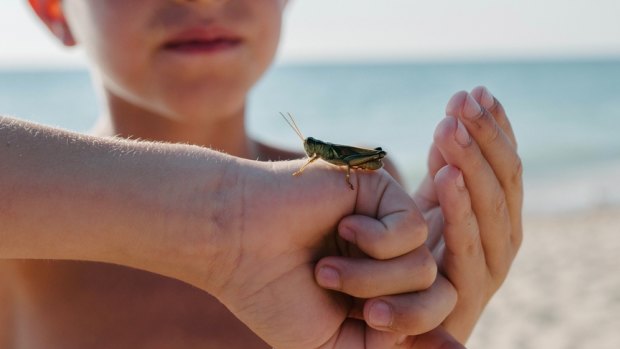This was published 6 years ago
Take half a cup of frozen crickets … are insects the next superfood?
By Paula Goodyer
I'm rich in protein, a source of iron and zinc – yet I'm not meat, fish, tofu or even an egg - what am I?
An edible insect.

Insects are for eating? Most of the world does it.Credit: Stocksy
You won't find packs of frozen crickets or meal worms in the supermarket yet, but edible insects are creeping on to the market. Protein bars with cricket powder are turning up in some health food shops, edible insect ingredients are available online and at least one Sydney cafe is doing a cricket powder smoothie.
Eating insects might seem weird to non-Indigenous Australians, yet 80 per cent of the world eats some kind of insect food, says dietitian Nicole Senior, who's launched an education service – Bug Me Insect Nutrition Education – to spread the word about the benefits of eating insects for humans and the planet.
"Besides being high in protein, edible insects are a useful source of vitamins and minerals such as riboflavin, vitamin B12 and calcium and also contain healthy mono and polyunsaturated fats, both omega-6 and omega-3," Senior says. "Compared to meat, insects have a much lighter ecological footprint – farming insects uses less water, less space, creates less waste and produces fewer greenhouse gases. We're becoming more aware of the impact of our diet on the planet and that we can't rely on food from animals as our main source of protein. We need to include other protein sources like legumes, nuts – and insects."
Raising insects for food requires far less feed than beef or pork according to the Food and Agriculture Organisation of the United Nations. While it takes 10 kilograms of feed to produce a kilo* of beef and five kilos of feed to produce a kilo* of pork, a kilo* of live insects takes just 1.5 kilos.
We're also adapted to eat insects, Senior says. "Insects contain a type of fibre called chitin which makes up their exoskeleton – humans have an enzyme called chitinase which digests chitin – so we're set up to eat them."
But how do you overcome the "ick" factor in a food culture where eating insects is considered gruesome (although it's perfectly fine to eat duck liver)?
The best entry point is something sweet such as brownies or protein balls that you can make with cricket powder, says Senior, whose recipe for cacao balls with crickets (below) blends cacao, walnuts date, prunes, maple syrup and whole crickets.
What do insects taste like?
"Whole insects don't taste like much at all – they're more of a carrier for other flavours like garlic and spices. I've used cricket powder in a seed bread and it adds a subtle earthy flavour but some people say it has hints of coffee or cacao," she says.
And while mealworms might sound, well, wormy, in fact they're dry and crisp and taste a bit like roasted peanuts, Senior adds.
At the University of Adelaide, associate professor Kerry Wilkinson from the school of agriculture, food and wine is researching consumer awareness of edible insects and their willingness to eat them.
"What we've learned so far is that 20 per cent of people we surveyed have already tried edible insects – usually mealworms, witchetty grubs or crickets – often while they were travelling. The most acceptable insects are witchetty grubs, crickets and ants – but not spiders or cockroaches. The most acceptable ways to eat them are in cookies, pastas made with insect flour or in a stir fry, says Wilkinson, who thinks moving towards more edible insect production either for feeding humans or for feeding livestock is inevitable to reduce the amount of land, water and resources needed to farm livestock.
"Another advantage is that insects can be fed on organic waste – in France, some vegetable producers send their waste to insect farms," she says.
While insects don't have fur or feathers, they're still living things that need to be farmed and then killed. The usual methods for dispatching insects is by reducing the temperature of their environment so they fall asleep and then freezing them before processing, or by putting the insects in an oxygen-free environment so they fall asleep and die, Wilkinson explains.
"You can argue that this is a less brutal approach than slaughtering livestock but for some people it will be an argument not to eat them. We assume insects are non-sentient but that's probably because no one's researched this. The jury's still out on whether or not insects have pain receptors."
Want to try edible insects? Cricket powder or roasted crickets are a good place to start, Senior says. You might find cricket powder and cricket protein bars in some health food stores, but most insect ingredients produced in Australia's two insect farms are sold online through Grubs Up and The Edible Bug Shop.
*Live animal weight
Cacao balls with crickets
Makes 30
Preparation time: 20 min
Chilling time: 20 min
½ cup (45g) whole frozen crickets
1 cup (125g) walnut pieces
1/3 cup (30g) raw cacao powder
250g dates (or date paste)
1/3 cup (60g) pitted prunes, chopped
2 Tablespoons maple syrup
1. Defrost crickets at room temperature. Pre-heat the oven to 1800C (3500F).
2. Roast crickets for around ten minutes, remove and set aside to cool.
2. Place the cooled crickets, walnuts and cacao powder in a food processor and process until course powder.
3. Add in the dates, prunes and maple syrup and process the ingredients they clump together.
4. Roll out into 2-3cm balls, place into mini cup cake papers and chill to set.
Notes
You could use or ½ cup roasted crickets, or ¼ cup cricket powder.
You could substitute the maple syrup for treacle, molasses, honey or golden syrup.